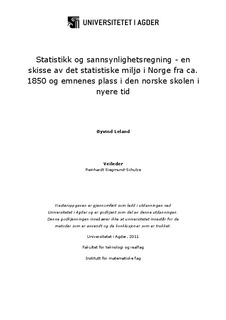| dc.description.abstract | The topic of this thesis is statistics and probability theory in Norway. The research question is: Which position has statistics and probability theory had in the Norwegian school, and how has the statistics environment developed in Norway from the middle of the 18th century?
First, I will provide a historical overview of how the statistics environment has developed in Norway from around 1850 and until 1960s-1970s. Statistisk sentralbyrå (1876), Den norske aktuarforening (1904), Norsk matematisk forening (1918) and Norsk statistisk forening (1936) will be central. I will also provide an overview of how the education in mathematical statistics culminated in the establishment of a university major (―hovedfag‖) in 1956, as well as how the actuary-education eventually became a university education in the beginning of the 19th century. A national debate about disability-insurance in Norway at the end of the 18th century and the beginning of the 19th century is also described. This is interesting in relation to den representative undersøkelsesmetoden, which was a predecessor of today’s sampling. A Norwegian named Anders Nicolai Kiær was probably the first to use this method, and it was used in the collection of information for the disability-insurance. In connection with this debate, the actuaries became involved, and argued against Kiær’s use of the method, using mathematical calculations, similar with what we today call confidence intervals.
The statistics and probability theories’ place in the Norwegian School is the largest part of the thesis. This part is both about the primary school and the secondary school. Curricula will be important sources, mainly the concrete goals in the curriculum which describe the content of statistics and probability teaching at school, and also textbooks and exams.
The first real sign of statistics and probability theory is found in a suggestion to a curriculum from 1964. This suggestion was not adopted, and in the new curriculum which came in 1976, these subjects were only represented at a small scale. Only some descriptive statistics was included, along with elective subjects which contained statistics and probability theory of a relatively broad range. There is some descriptive statistics in the curriculum from 1974 and this content has increased in the curriculum in 1986. Probability theory is also represented in a proper way for the first time in that curriculum. In the next curriculum in 1997, the portion of statistics and probability theory within the total content again increases, and probability is also represented in the curriculum in the lower primary school. In Kunnskapsløftet from 2006, there are minor differences from the curriculum of 1997.
The concept of chance is introduced in the school, according to the curriculum, normally towards the end of the lower primary school. By reviewing some books for the last grade of the lower primary school, I have found that chance or probability are often introduced by using examples of throwing dice, coin, etc.
In the secondary school, statistics and probability theory first appeared in the curriculum in 1994 in a comprehensive way, after pressure from the authorities and the statistical environment. R94 was revised when the curriculum for the primary school took effect in 1997, with small adjustments within statistics and probability theory. When Kunnskapsløftet came in 2006, the scope of statistics and probability theory were smaller. This is probably connected with an attempt to improve the mathematics subject in general. The books from secondary school show that basic probability theory is presented fairly equally in several different textbooks, often with the use of examples as throwing dice, coin etc. When it comes to mathematical statistics, there are bigger differences both in relation to the scope and presentation of the subjects. Probability theory of a more complicated kind, as for example the law of large number and the central limit theorem, is often formulated in an intuitive way. | en_US |
